Disclosure: We may earn commissions if you purchase products after clicking on a link from our site.
If you want to become a skilled greater prairie chicken hunter, there are key strategies you must grasp. From understanding their habitat to employing the right equipment, success hinges on a blend of knowledge and technique. By learning the nuances of their behavior and employing smart hunting tactics, you can increase your chances of a successful hunt. So, let’s begin by exploring the essential elements that will elevate your prairie chicken hunting game to the next level.
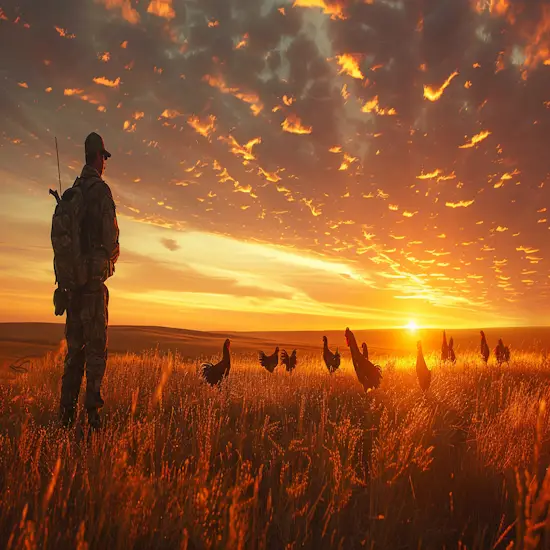
Table of Contents
- 1 Key Takeaways
- 2 Understanding the Greater Prairie Chicken
- 3 Regulations and Licensing
- 4 Equipment for Greater Prairie Chicken Hunting
- 5 Clothing and Gear
- 6 Dogs
- 7 Hunting Techniques
- 8 Shot Placement
- 9 Field Dressing
- 10 Prime Hunting Locations
- 11 Best States to Hunt Greater Prairie Chicken
- 12 Greater Prairie Chicken Hunting Tips
- 13 How to Hunt Greater Prairie Chicken With a Dog
- 14 How to Hunt Greater Prairie Chicken Without a Dog
- 15 Safety
- 16 The Bottom Line
Key Takeaways
- Use decoys and calls to attract birds.
- Hunt near agriculture fields for better chances.
- Aim for the head with shotguns for instant fatality.
- Avoid body shots for humane hunting.
- Scout in tallgrass prairies for optimal hunting spots.
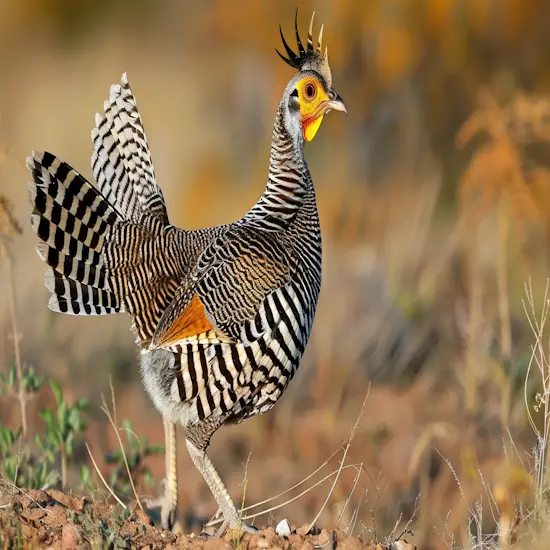
Understanding the Greater Prairie Chicken
To understand the greater prairie chicken, you must grasp its unique biology and behavior. These birds are known for their elaborate mating displays, which involve distinct features like long neck feathers and vibrant neck sacks.
Observing their behaviors in their natural habitats can offer valuable insights into their survival strategies and habitat preferences.
Biology and Behavior
To understand the greater prairie chicken better, let’s explore its species, diet, habitat, behavior, and range. Knowing these key aspects can enhance your hunting strategies and appreciation for this unique bird.
Species
Understanding the biology and behavior of the greater prairie chicken is essential for successful hunting experiences. Greater prairie chickens are known for their distinctive mating dance and unique features such as long neck feathers and yellow neck sacks.
Non-migratory birds, they face challenges due to habitat loss in native prairies. Preferred habitats include tallgrass prairies with dispersed croplands and oak woodlands.
Hunting techniques vary based on the season, with early season hiking and late season pass shooting recommended.
Diet
The diet of greater prairie chickens primarily consists of seeds, insects, and green vegetation found in their habitat.
| Food Source | Description | Importance |
|---|---|---|
| Seeds | Main source of energy for the birds | Essential |
| Insects | Rich in protein and essential for growth | Critical |
| Vegetation | Provides essential nutrients and fiber | Required |
Habitat
Discover the preferred habitats of greater prairie chickens, which is important for understanding their biology and behavior.
Look for flat country with native grasses and avoid thick grass or low-lying areas. Prairie chickens favor rolling prairies with crops, attracting them to grasslands.
Elevated ground is preferred, influencing their survival. Habitat is important in locating these birds, making it essential for successful hunting endeavors.
Behavior
To grasp the behavior of the greater prairie chicken, consider their unique mating rituals and habitat preferences.
- Males dance to attract females, showcasing flamboyant feathers.
- Birds gather in leks, displaying dominance and courtship.
- Habitat destruction threatens their traditional breeding grounds.
Range
Explore the expansive range of the greater prairie chicken, encompassing diverse habitats across the central United States. These birds inhabit grasslands, prairies, and agricultural areas from Minnesota to Texas.
The greater prairie chicken’s range historically extended over millions of acres, but habitat loss has limited their distribution. Understanding their range is essential for successful hunting and conservation efforts.

Regulations and Licensing
When preparing for your prairie chicken hunting expedition, it’s important to familiarize yourself with the legal requirements. Check your state regulations for specifics on hunting permits and bag limits before heading out.
Remember to always respect private property rights and obtain permission before hunting on private land.
Legal Requirements
When preparing for your greater prairie chicken hunting adventure, make sure you have the necessary hunting license as per state regulations. Familiarize yourself with the hunting season dates and bag limits to abide by legal requirements.
Remember to respect private property rights and obtain permission before venturing onto any private lands for hunting.
Hunting License
Understanding the legal requirements for obtaining a hunting license is essential for any individual looking to engage in prairie chicken hunting.
- Guarantee you meet the age and residency requirements.
- Familiarize yourself with the specific regulations for hunting prairie chickens.
- Secure the necessary permits and licenses before heading out into the field.
Hunting Season
Guarantee compliance with hunting season regulations by obtaining the necessary permits and licenses before embarking on your prairie chicken hunting expedition.
Make sure to check for specific hunting season dates and any restrictions imposed by state regulations. Avoid legal issues by adhering to hunting season guidelines and acquiring the proper documentation in advance.
Stay informed about any changes in hunting regulations to secure a successful and lawful hunting experience.
| State | Season | Bag Limit |
|---|---|---|
| Kansas | Mid-November to Late January | 2 per day |
| Nebraska | Mid-September to Late December | 3 per day |
| South Dakota | Late September to Early January | 3 per day |
Bag Limits
To comply with legal requirements while hunting prairie chickens, familiarize yourself with the bag limits set by state regulations.
- Confirm you know the daily bag limit to avoid exceeding the allowed number of birds.
- Understand any possession limits in place to prevent violations.
- Respect conservation efforts by adhering to the bag limits and contributing to sustainable hunting practices.
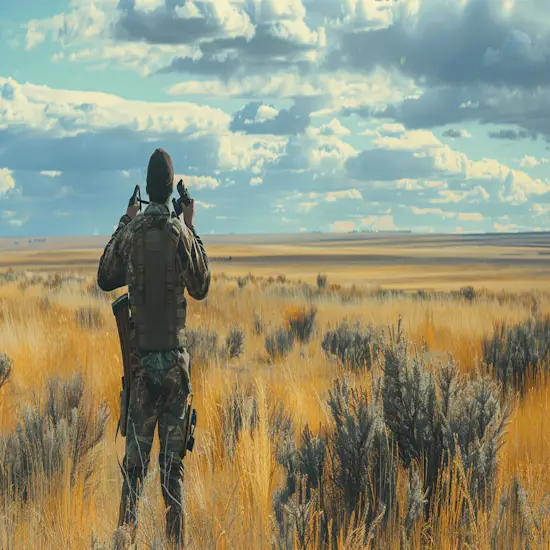
Equipment for Greater Prairie Chicken Hunting
You need the right gear for successful greater prairie chicken hunting. Make sure you have a shotgun or rifle handy, along with binoculars for scouting. Don’t forget to pack extra ammunition and either a GPS device or a detailed map for navigation.
Shotguns
When preparing for greater prairie chicken hunting, selecting the right shotgun is essential for maximizing your hunting success. Here are three key factors to keep in mind when choosing your shotgun:
- Shot Size Matters:
Opt for shot sizes like #6 or #7.5 for Greater Prairie Chicken hunting. These sizes offer a good balance between pellet count and energy delivery, increasing your chances of a successful harvest without harming the bird excessively.
2. Take Shotgun Weight into Account:
A lighter shotgun can be beneficial during long hunting days, reducing fatigue and allowing for quicker handling when targeting fast-moving prairie chickens. However, a heavier shotgun might provide better stability for improved accuracy.
3. Shotgun Fit is Essential:
Ensure your shotgun fits you well to enhance your shooting accuracy and comfort. A properly fitted shotgun can help you aim more naturally and follow through effectively, improving your chances of a clean shot.
Selecting the right shotgun tailored to your preferences and hunting style can have a significant impact on your Greater Prairie Chicken hunting experience.
Rifles
For Greater Prairie Chicken hunting, selecting the appropriate rifle is crucial for a successful hunting experience. When choosing a rifle, opt for a caliber like .22 or .17 HMR for precision shooting. These calibers are ideal for the size of prairie chickens and offer accuracy at various ranges.
A scoped rifle can enhance your targeting abilities, especially when shooting from a distance. Verify your rifle is properly sighted in before heading out to hunt. Consider factors like weight, barrel length, and the overall fit of the rifle to ensure comfort during long hunting sessions.
Additionally, invest in quality ammunition to maximize your chances of a clean shot. Remember to follow all firearms safety protocols and regulations while hunting. By selecting the right rifle and practicing your shooting skills, you can increase your chances of a successful Greater Prairie Chicken hunting expedition.
Binoculars
Binoculars play a vital role in enhancing your field of vision during Greater Prairie Chicken hunting expeditions. Here are three essential points to keep in mind when selecting binoculars for your hunt:
- Clarity:
Opt for binoculars with high-quality lenses to ensure clear and sharp images of prairie chickens even at a distance. Clear optics can help you spot subtle movements and behaviors of the birds, enhancing your hunting experience.
2. Durability:
Choose binoculars that are rugged and weatherproof to withstand the outdoor conditions you may encounter while hunting prairie chickens. Sturdy binoculars can endure rough handling and varying weather elements, ensuring they remain reliable throughout your expedition.
3. Magnification:
Select binoculars with an appropriate magnification level that suits your hunting style. Higher magnification can help you observe distant prairie chickens in detail, while lower magnification provides a wider field of view for tracking birds in motion. Opting for the right magnification can greatly assist in locating and targeting your game effectively.
Ammunition
Consider selecting the appropriate ammunition for your Greater Prairie Chicken hunting expedition based on the recommended shot sizes and shotgun chokes provided for different hunting scenarios.
For hunting Greater Prairie Chickens, commonly used shot sizes range from #6 to #8, with #7.5 being a popular choice due to its balanced performance. These shot sizes offer effective patterns for hitting these birds at varying distances.
When it comes to shotgun chokes, improved cylinder or modified chokes are often suggested for this type of hunting. The improved cylinder choke provides a wider spread, suitable for closer shots, while the modified choke offers a slightly tighter pattern for mid-range shooting.
Make sure you have the right combination of shot size and shotgun choke to maximize your chances of a successful hunt. Proper ammunition selection can greatly impact your accuracy and overall hunting experience.
GPS or Map
Utilize a GPS device or map to navigate and locate prime hunting spots for Greater Prairie Chickens effectively. When out in the field, having the right tools can make all the difference in your hunting success.
Here are three reasons why using a GPS or map is crucial:
- Precision: A GPS device or map allows you to pinpoint the exact locations of leks and preferred habitat areas, increasing your chances of encountering Greater Prairie Chickens.
- Efficiency: Save time and effort by effectively planning your hunting route and avoiding areas where the birds are less likely to be found.
- Safety: Knowing your location and how to navigate back to your starting point guarantees a safe hunting experience, especially in vast prairie landscapes where landmarks may be scarce.
Blaze Orange Vest and Hat
Wearing a bright orange vest and hat is crucial for your safety and visibility while hunting Greater Prairie Chickens. The vivid orange hue stands out amidst the natural prairie backdrop, making it simpler for fellow hunters to spot you and decreasing the chance of unintended shootings.
These eye-catching garments indicate your presence, aiding in your visibility in the tall grass where prairie chickens often conceal themselves. The hat guarantees visibility from all directions, while the vest provides extra coverage as you navigate through the hunting grounds.
Remember, safety is of utmost importance in the field, and by donning bright orange attire, you boost your protection and that of others nearby. Prior to setting out, make sure to verify that your vest and hat are in good shape and conform to the required safety regulations.
Stay secure, stay noticeable, and relish your Greater Prairie Chicken hunting adventure with the appropriate equipment.
Sturdy Boots
Sturdy boots are essential gear for your Greater Prairie Chicken hunting expedition. When out in the field, you need reliable footwear to navigate through various terrains and withstand long hours of walking.
Here are three key items to keep in mind when choosing your sturdy boots:
- Durability: Opt for boots made of high-quality materials like leather or synthetic waterproof fabrics. The rugged prairie terrain can be tough on footwear, so durability is vital for lasting comfort and protection.
- Traction: Look for boots with excellent grip and traction. Whether you’re walking through slick grasslands or muddy patches, having solid traction will help prevent slips and falls, ensuring your safety during the hunt.
- Comfort: Prioritize comfort when selecting your boots. Make sure they provide ample support for your feet and ankles, especially if you plan on spending hours tracking prairie chickens. Comfortable boots can prevent fatigue and blisters, allowing you to focus on your hunt.
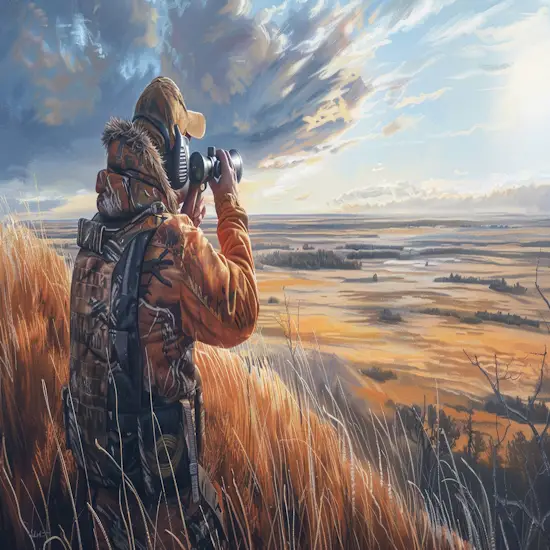
Clothing and Gear
When gearing up for hunting Greater Prairie Chickens, make sure to dress appropriately for the terrain and weather conditions. Opt for camouflage clothing to blend in seamlessly with the surroundings. Sturdy footwear is essential for long treks in grasslands.
Don’t forget to bring along essential hunting gear like binoculars and a hunting pack. Being properly equipped will enhance your hunting experience and increase your chances of a successful outing.
Clothing
Proper attire is essential for a successful prairie chicken hunting expedition. To make sure you’re adequately prepared for your hunting adventure, consider the following clothing items:
- Camo Clothing: Opt for camouflage attire in earthy tones to blend seamlessly into the prairie chicken’s natural habitat. This will help you stay unnoticed and increase your chances of a successful hunt.
- Layered Clothing: Dress in layers to regulate your body temperature effectively. Mornings on the prairie can be chilly, while afternoons might bring warmer weather. Being able to adjust your clothing accordingly will keep you comfortable throughout the day.
- Quality Boots: Invest in sturdy, waterproof boots with excellent traction. Moving through uneven terrain and potentially wet grasslands requires reliable footwear to keep your feet dry and secure.
Footwear
Consider your footwear as an essential component of your hunting gear when preparing for a successful prairie chicken expedition.
Opt for sturdy, waterproof boots with excellent traction to navigate the varied terrain you may encounter. The tallgrass prairies can be uneven and may hide unexpected obstacles, so ankle support is pivotal to prevent injuries. Choose boots that provide comfort for long treks and are breathable to keep your feet dry and cool.
Insulated options are beneficial for colder weather hunting, ensuring your feet stay warm and comfortable. Additionally, select a neutral color like brown or green to blend in seamlessly with the natural surroundings, aiding in camouflage.
Proper footwear not only enhances your hunting experience but also protects your feet from potential hazards, allowing you to focus on the thrill of the hunt.
Other Gear
Selecting appropriate attire and gear is crucial for a successful prairie chicken hunting journey. When gearing up for your adventure, make sure you have the following items to enhance your experience:
- Camouflage Clothing: Opt for camouflage attire in green and brown shades to blend seamlessly with the prairie surroundings. This will help you stay unnoticed by the sharp eyes of the greater prairie chickens.
- Quality Binoculars: Invest in a good set of binoculars to scout for prairie chickens from a distance. This will allow you to observe their movements and behavior without alerting them to your presence.
- Comfortable Boots: Choose comfortable and sturdy boots designed for rugged terrains. Reliable footwear with excellent ankle support will keep you stable as you navigate through the prairies in search of your elusive prey.
Armed with the right clothing and gear, you’ll be well-prepared to set off on a successful greater prairie chicken hunting journey.
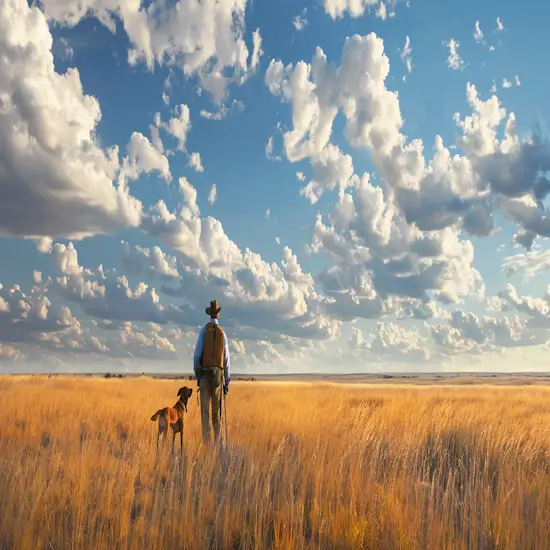
Dogs
When hunting Greater Prairie Chickens, your choice of dog breed and training are important factors. Different breeds excel in pointing and retrieving, so select one that fits your hunting style. Proper training guarantees your dog’s behavior aligns with successful hunting practices.
Breeds
To effectively hunt Greater Prairie Chickens, understanding the ideal dog breeds for this activity is essential. When choosing a hunting companion, consider these key factors:
- Loyalty: A loyal dog is vital for prairie chicken hunting as they need to work closely with you to locate and flush out the birds effectively. A loyal dog will stay focused on the task at hand and follow your commands promptly.
- Stamina: Hunting prairie chickens can be physically demanding, requiring a dog with high endurance to cover long distances and endure varying terrains. A dog with excellent stamina will be able to keep up with the rigorous pace of the hunt without tiring quickly.
- Trainability: Opt for a dog breed known for its trainability, as prairie chicken hunting involves complex tasks like scenting, pointing, and retrieving. A highly trainable dog will grasp commands quickly and perform tasks efficiently, enhancing your hunting success.
Training
Enhancing your hunting experience with Greater Prairie Chickens involves focusing on dog training. Training your hunting dog to effectively work with you in the field can greatly boost your success rate. Below is a simple table outlining key aspects of dog training to take into account:
| Training Aspect | Description |
|---|---|
| Obedience Training | Teaching basic commands like sit, stay, and come |
| Field Training | Practicing retrieving, pointing, and flushing |
| Socialization | Exposing your dog to various environments and people |
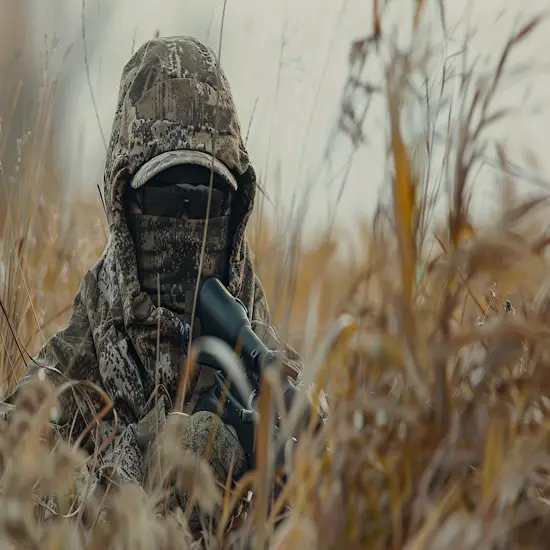
Hunting Techniques
To improve your prairie chicken hunting experience, it’s essential to master various techniques. Scouting helps you locate prime spots while walking and flushing can surprise birds into flight. Utilize spot and stalk, calling, and pass shooting methods for successful hunts.
Scouting
When scouting for Greater Prairie Chickens, focus on their preferred habitats like tallgrass prairies and areas with dispersed croplands.
Look for signs of their presence such as fresh scat, feathers, and lekking grounds. Understanding their habitat and recognizing these signs will enhance your chances of a successful hunt.
Habitat
To maximize your prairie chicken hunting success, focus on scouting the ideal habitat for these birds. Look for flat country with native grasses. Grasslands with crops attract prairie chickens. Avoid thicker grass and low-lying scrubby areas.
Signs
Look for key signs such as fresh scat and feathers to locate potential prairie chicken hunting grounds effectively. These indicators suggest recent bird activity in the area.
By paying attention to these signs, you can narrow down your search and increase your chances of encountering greater prairie chickens. Keep an eye out for these clues as you scout for ideal hunting spots in the prairie chicken habitat.
Walking and Flushing
When employing the walking and flushing technique while hunting Greater Prairie Chicken, your steps should be deliberate and quiet to avoid startling the birds.
Utilize well-trained dogs to locate and flush out the birds from their cover, increasing your chances of a successful hunt.
Remember that patience and attentiveness are key in this method as you navigate the terrain and work alongside your canine companions.
Technique
For successful prairie chicken hunting, mastering the walking and flushing technique is essential.
- Move quietly through grasslands to avoid startling the birds.
- Use the wind to your advantage to mask your scent.
- When a prairie chicken is flushed, keep calm and aim carefully for a successful shot.
Dogs
To enhance your prairie chicken hunting experience, incorporating well-trained dogs can greatly improve your success rate in locating and flushing out birds. Utilize dogs for walking and flushing techniques, allowing them to sniff out and scare up hidden birds.
Train your dogs to work efficiently in the field, helping you cover more ground and increase your chances of a successful hunt.
Spot and Stalk
To excel in spot and stalk hunting for Greater Prairie Chicken, focus on stealth and patience. You’ll need to move quietly and blend into the surroundings to get close enough for a successful shot. Observing the birds’ behavior and habitat preferences can enhance your hunting strategy.
Technique
When hunting Greater Prairie Chickens using the spot and stalk technique, it’s essential to move quietly and strategically to approach the birds successfully.
- Walk stealthily to avoid startling the birds.
- Use natural cover to conceal your movements.
- Plan your approach carefully to get within shooting range without alerting the prairie chickens.
Calling
When hunting greater prairie chickens, mastering calling techniques is essential. You can use different types of calls to attract these elusive birds closer to your hunting spot. Understanding how to effectively use calls can enhance your chances of a successful hunt.
Types of Calls
For successful prairie chicken hunting, mastering different types of calls is essential.
- Mimicking the mating call to attract males.
- Using distress calls to provoke a protective response.
- Employing territorial calls to establish dominance.
Using Calls
To enhance your prairie chicken hunting success, incorporating effective calling techniques is essential. Mimic the sounds of prairie chickens using calls like the cackle or boom call. Practice different tones and volumes to attract birds.
Use calls strategically to lure them closer for a successful shot. Mastering these techniques can greatly enhance your chances of a fruitful hunt.
Pass Shooting
Blend into the natural environment using green and brown hues when pass shooting prairie chickens for best camouflage effectiveness.
When engaging in pass shooting, remember these key points:
- Stay Focused: Keep your eyes peeled for any movement in the sky. Greater prairie chickens can swiftly take off, so stay alert and ready to take your shot.
- Timing is Key: Patience is essential when pass shooting. Wait for the right moment to aim and fire. Rushing can lead to missed opportunities.
- Shoot with Precision: Aim for the leading bird when targeting a flock. By focusing on one bird at a time, you increase your chances of a successful shot.
Decoy Hunting
Utilize decoys strategically to enhance your prairie chicken hunting strategies. Decoy hunting involves placing realistic decoys that mimic prairie chickens in their natural environment to attract real birds.
Position decoys in open areas near cover to make them visible from a distance. Consider using a mix of hen and rooster decoys to create a more convincing setup. Place decoys facing various directions to simulate a natural group of feeding or resting birds.
Keep decoys clean and free from debris to maintain their lifelike appearance. Additionally, adjust decoy placement based on wind direction to make sure that approaching birds can spot them easily.
Remember to remain concealed and motionless while waiting for birds to approach the decoys. Once birds are within range, carefully take your shot. Decoy hunting can be a successful method when executed thoughtfully, enhancing your chances of a rewarding prairie chicken hunting experience.
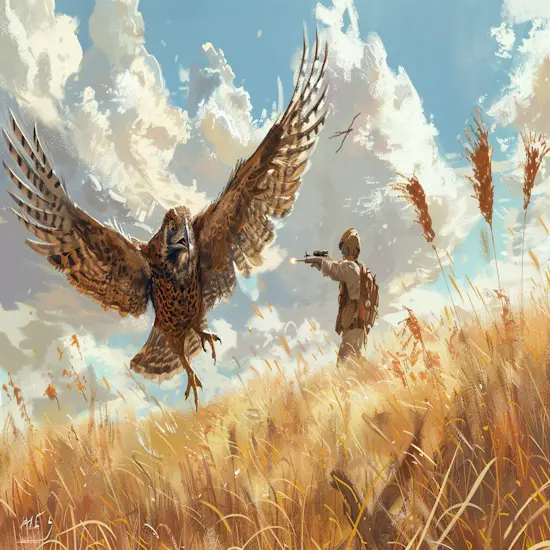
Shot Placement
For successful hunting of greater prairie chickens, aim for accurate shot placement to guarantee quick and ethical kills. When you’re out in the field, remember these important tips:
- Heart and Lung: Aim for the essential organs to ensure a swift and humane takedown of the bird. This shot placement is effective in bringing down the prairie chicken without unnecessary suffering.
- Headshot: If you’re confident in your marksmanship skills, a well-placed headshot can be instantly fatal, preventing any chance of the bird escaping wounded. However, this shot requires precision due to the small target area.
- Avoid Body Shots: Make an effort to avoid body shots that can lead to prolonged suffering or a lost bird. Focus on hitting essential areas to make the most ethical kill possible.

Field Dressing
Prepare to field dress your harvested greater prairie chicken by following these simple steps. Begin by laying the bird on its back and making a small incision between the breastbone and the vent. Carefully cut through the skin and feathers, making sure not to puncture the internal organs.
Next, gently reach inside and remove the entrails, taking care not to burst any organs. Once the cavity is clean, rinse the bird with cool water to remove any debris. Consider saving the heart and liver for consumption if desired.
Finally, pat the bird dry with a clean cloth or paper towel before storing it properly. Remember to dispose of the entrails responsibly and wash your hands thoroughly after field dressing.
Proper field dressing guarantees the quality of the meat and prepares the bird for further processing or cooking. With these steps, you can efficiently field dress your greater prairie chicken and enjoy the fruits of your hunt.

Prime Hunting Locations
When looking for prime hunting locations to pursue greater prairie chickens, consider exploring public lands with hunting pressure and private lands with grasslands that offer less pressured birds.
Public lands in Kansas and CRP areas can provide hunting opportunities, while private lands may offer insider tips and higher bird numbers. Access programs like Wing It can facilitate entry to private lands for unique hunting experiences.
Public Lands
When hunting for Greater Prairie Chickens, consider exploring National Grasslands, State Parks, and Wildlife Management Areas (WMAs) for prime hunting locations.
These public lands offer diverse habitats and opportunities to encounter prairie chickens in their natural environment.
Be sure to research specific regulations and access requirements for each location before venturing on your hunting expedition.
National Grasslands
Consider exploring the National Grasslands for prime hunting locations on public lands.
- Discover vast open spaces teeming with prairie chicken opportunities.
- Experience the thrill of hunting in untouched natural settings.
- Connect with the beauty of the great outdoors while pursuing your passion for hunting.
State Parks and Wildlife Management Areas (WMAs)
Explore State Parks and Wildlife Management Areas (WMAs) as prime hunting locations on public lands for your next prairie chicken adventure. These areas offer diverse habitats and opportunities to encounter greater prairie chickens.
State parks and WMAs are managed to support wildlife populations, providing a conducive environment for hunting. Consider these public lands for a rewarding and challenging hunting experience with greater prairie chickens.
Private Lands
When hunting on private lands for Greater Prairie Chickens, securing landowner permission is key. Some areas may be leased for hunting, offering exclusive access to prime locations.
Make sure to respect property rights and follow any regulations or guidelines set by landowners for a successful and ethical hunting experience.
Landowner Permission
To access prime hunting locations on private lands, securing landowner permission is essential for a successful and respectful hunting experience.
- Respecting the Land: Acknowledge the landowner’s rights and stewardship.
- Building Relationships: Establish trust for potential future access.
- Ensuring Safety: Understand property boundaries and any potential hazards.
Leased Land
Securing access to leased land for hunting on prime locations can greatly enhance your chances of a successful and rewarding hunting experience. Private lands often provide less pressured birds and insider tips for better hunting opportunities.
Programs like Wing It can facilitate access to these exclusive hunting grounds, allowing you to enjoy high bird numbers and a unique experience while respecting landowner rights and regulations.

Best States to Hunt Greater Prairie Chicken
When considering the best states to hunt Greater Prairie Chicken, focus on Kansas, Nebraska, and South Dakota. These states offer prime hunting locations with abundant opportunities to pursue this unique species.
Be sure to explore the vast prairies and grasslands that these states have to offer for a rewarding hunting experience.
Kansas
In Kansas, you can find some of the best opportunities for hunting Greater Prairie Chicken.
Rich Hunting Grounds: Kansas offers vast expanses of prairie lands, providing ideal habitats for Greater Prairie Chicken populations. The state’s diverse landscapes create ample opportunities for successful hunts.
Abundant Wildlife: With its thriving prairie chicken population, Kansas ensures that hunters have plentiful chances to spot and pursue these unique game birds. The abundance of wildlife adds excitement and satisfaction to your hunting experience.
Scenic Beauty: Hunting in Kansas allows you to immerse yourself in the picturesque Flint Hills and other stunning natural environments. The scenic beauty of the state enhances your hunting adventure, making it not just a pursuit but a memorable journey in itself.
Nebraska
Kansas offers abundant hunting grounds for Greater Prairie Chicken, but if you’re searching for another top destination, consider Nebraska, recognized as one of the best states to hunt these game birds. Nebraska’s vast prairies and grasslands provide ideal habitats for Greater Prairie Chickens, offering hunters excellent opportunities to pursue these elusive birds.
The state’s diverse landscape and combination of croplands and grassy fields attract prairie chickens, making Nebraska a popular destination for experienced hunters and beginners alike.
When planning your hunting trip to Nebraska, focus on regions like the Sandhills and the Rainwater Basin, where Greater Prairie Chickens are frequently found. These areas provide ample space for hunting and offer stunning views of the natural surroundings.
Additionally, Nebraska’s hunting regulations are crafted to guarantee sustainable populations of prairie chickens, enabling a rewarding and ethical hunting experience. So, pack your gear, head to Nebraska, and immerse yourself in the excitement of hunting Greater Prairie Chickens in one of the best states for this exhilarating pursuit.
South Dakota
For those seeking prime hunting opportunities for Greater Prairie Chicken, South Dakota stands out as one of the best states to explore. Here’s why:
- Abundance of Wildlife: South Dakota offers vast expanses of prairie habitat where Greater Prairie Chickens thrive, providing hunters with ample opportunities to spot and pursue these elusive birds.
- Scenic Landscapes: The rolling prairies and open skies of South Dakota create a picturesque backdrop for your hunting adventures, immersing you in the beauty of nature as you seek out these majestic birds.
- Rich Hunting Tradition: With a deep-rooted hunting culture and a strong conservation ethic, South Dakota welcomes hunters to experience the thrill of pursuing Greater Prairie Chickens while contributing to wildlife management efforts in the region.
Embark on your hunting journey in South Dakota and immerse yourself in a landscape teeming with wildlife, where every step brings you closer to the fascinating world of Greater Prairie Chickens.
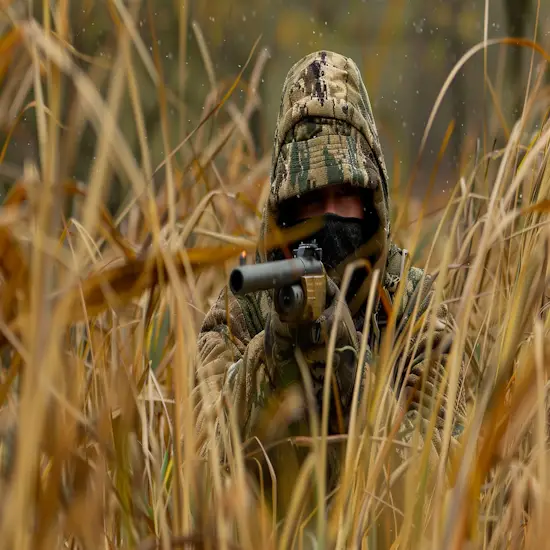
Greater Prairie Chicken Hunting Tips
To improve your Greater Prairie Chicken hunting success, consider incorporating advanced tactics and specialized strategies. When hunting these elusive birds, it’s pivotal to focus on specific techniques that can enhance your chances of a successful hunt.
Start by locating Greater Prairie Chicken leks, where males display and visit daily. Look for elevated spots, areas with sparse vegetation, near stock tanks, ponds, or prairie dog towns. The presence of fresh scat and feathers can indicate bird activity.
Hunting near agriculture fields like alfalfa and soybeans can attract birds, providing moisture, insects, and food sources. Choosing the right shot size and shotgun chokes based on the season and range is vital for effective shooting distances.
Additionally, understanding habitat preferences, adapting to wind conditions, and avoiding tall grass areas can greatly impact your hunting outcomes. By implementing these tips and strategies, you can optimize your Greater Prairie Chicken hunting experience and increase your likelihood of a successful hunt.

How to Hunt Greater Prairie Chicken With a Dog
When hunting Greater Prairie Chicken with a dog, focus on utilizing specific dog breeds known for their pointing abilities to enhance your hunting experience.
Here are three key tips for a successful hunt:
- Choose the Right Breed: Opt for breeds like English Setters, German Shorthaired Pointers, or Brittany Spaniels known for their excellent pointing skills. These breeds can help locate and point out the prairie chickens, making your hunt more efficient and enjoyable.
- Training is Key: Make sure your dog is well-trained in both obedience and hunting skills. Practice commands like ‘sit,’ ‘stay,’ and ‘fetch’ to maintain control in the field. Proper training won’t only benefit your hunt but also strengthen the bond between you and your furry hunting companion.
- Consider Professional Help: If you’re new to hunting with a dog or facing challenges with training, think about seeking assistance from professional trainers. They can offer valuable guidance on optimizing your dog’s hunting abilities, enhancing your overall hunting experience.
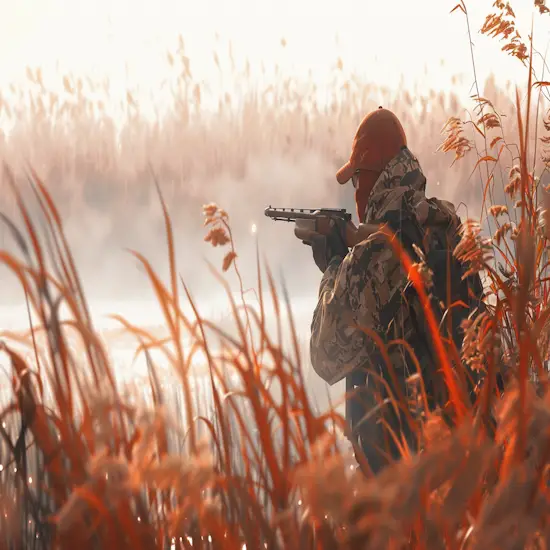
How to Hunt Greater Prairie Chicken Without a Dog
Consider employing stealth and patience when pursuing Greater Prairie Chicken without a dog. To hunt these birds solo, start by scouting for leks and signs of bird activity near water sources or prairie dog towns.
Opt for camouflage clothing in green and brown hues to blend into the environment. Set up along fence lines, tree rows, or field edges where prairie chickens frequent. Patience is key; wait for the birds to fly within range before taking your shot.
Remember to watch for sentinels acting as lookout posts for the flock and adjust your position accordingly to stay hidden. Avoid tall grass areas and focus on open spaces where the birds are more likely to roam. By moving quietly and strategically, you can increase your chances of a successful hunt without the aid of a dog.
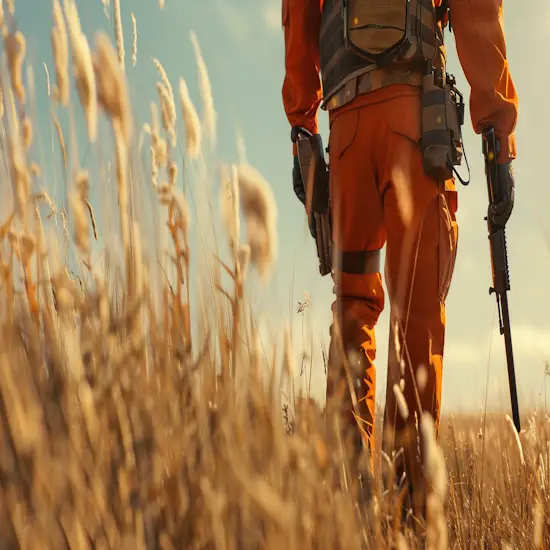
Safety
When hunting Greater Prairie Chicken, remember the importance of firearm safety first and foremost. Always be aware of your surroundings and the environmental factors that may affect your hunt.
Additionally, if hunting in a group, prioritize group safety to guarantee a successful and incident-free experience.
Firearm Safety
Remember, always treat firearms as if they’re loaded. Be certain of your target and what’s beyond it before shooting. Practice safe handling techniques at all times to guarantee a successful and secure hunting experience.
Always Treat Firearms as Loaded
Always handle firearms as if they’re loaded to prioritize safety at all times.
- Never assume a firearm is unloaded.
- Keep the muzzle pointed in a safe direction.
- Finger off the trigger until ready to shoot.
Be Sure of Your Target
Verify that you positively identify your target before aiming and firing your firearm to prevent accidents and promote safe hunting practices. Confirm that you’re aiming at a Greater Prairie Chicken and not a similar-looking species.
Avoid shooting at movement or sounds alone. Take the time to observe and ascertain your target is clear before pulling the trigger. Safety and accuracy are paramount in successful prairie chicken hunting.
Safe Handling
Prioritize proper firearm handling during prairie chicken hunting to prioritize safety at all times.
- Always treat every firearm as if it’s loaded.
- Keep your finger off the trigger until ready to shoot.
- Be aware of your target and what lies beyond.
Environmental Awareness
Pay close attention to weather conditions while hunting Greater Prairie Chicken. Sudden changes can affect your safety and success. Stay aware of wildlife behavior in the area to anticipate any potential risks.
Weather Conditions
When planning your prairie chicken hunting excursion, being mindful of weather conditions is essential for ensuring safety and environmental awareness.
- Check for extreme temperatures to prevent dehydration or hypothermia.
- Be aware of sudden weather changes to avoid getting caught in dangerous conditions.
- Plan accordingly for windy days, as it can impact the flight patterns of prairie chickens.
Wildlife Awareness
Check for signs of wildlife presence and behavior to boost your safety and environmental awareness during your prairie chicken hunting expedition. Be mindful of fresh scat, feathers, and tracks indicating bird activity. Avoid disturbing nesting areas or dens.
Stay alert to sudden movements or sounds indicating nearby wildlife. Respect the natural habitat and wildlife patterns to guarantee a harmonious hunting experience.
Group Hunting Safety
When hunting in a group, clear communication is key to guarantee everyone’s safety. Make sure to establish a system where each member communicates their position effectively. Positioning is essential; always be aware of where your fellow hunters are to prevent any accidents.
Communication
To guarantee group hunting safety during your prairie chicken hunting expeditions, effective communication among all members is paramount. Here are three important communication practices to secure a safe and successful hunt:
- Establish clear signals for alerting others of potential hazards.
- Agree on a communication plan for moving through the hunting grounds.
- Regularly update each other on your locations and movements.
Positioning
Establishing proper positioning within your hunting group is essential for ensuring safety and coordination during prairie chicken hunting expeditions. Maintain a staggered line formation to prevent crossfire incidents, ensuring each member has a clear line of sight.
Communicate effectively to signal bird sightings and movements. Stay vigilant and aware of your surroundings, adjusting positions accordingly to maintain a safe and effective hunting strategy.
The Bottom Line
Learning how to hunt greater prairie chicken can be a rewarding experience that connects you with a unique part of America’s natural heritage. By understanding the bird’s behavior, habitat preferences, and employing effective hunting techniques, you can increase your chances of a successful hunt.
Remember to always prioritize safety, follow regulations, and contribute to conservation efforts to ensure the sustainability of this magnificent species for future generations. Whether you’re a seasoned hunter or new to the sport, the challenge of pursuing greater prairie chickens offers an unforgettable outdoor adventure.
Whether you hunt with a dog or not, always be certain of your target and exercise caution. As the proverb goes, ‘better safe than sorry,’ so take the essential precautions for a successful and secure hunting experience.
Additionally, you can also read how to hunt lesser prairie chicken, how to hunt wild turkeys, and how to hunt ring-necked pheasants.